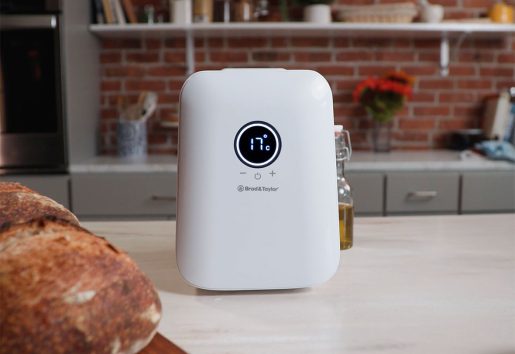![]() Sourdough Home for controlling sourdough starterUseprecise temperatures to control your starter like never before. The Sourdough Home is designed to keep your starter at the perfect temperature, whether by heating or cooling. Feed your starter according to your schedule: from twice a day to once a week. Change the temperature to adjust the flavor profile, aroma and texture of your bread.
Sourdough Home for controlling sourdough starterUseprecise temperatures to control your starter like never before. The Sourdough Home is designed to keep your starter at the perfect temperature, whether by heating or cooling. Feed your starter according to your schedule: from twice a day to once a week. Change the temperature to adjust the flavor profile, aroma and texture of your bread.
€ 129,00
Precise temperature control.
You can easily control the temperature of your starter with the Sourdough Home. With the precise temperature control from 5 – 50 °C, you can maintain a constant temperature or vary the temperature to control the growth rate, aroma and taste of your bread.


Your sourdough starter. Your schedule.
Customize the feeding schedule, from hours to days, even once a week, and vary the temperature to control the aroma and flavor profile of your bread.
A sourdough starter is a living colony of yeast and good bacteria. Like every living creature, it needs food – just flour and water. Feeding the starter with the right ingredients at the right time is the first step in making good sourdough bread. With the Sourdough Home’s precise temperature control, you can adjust the starter’s feeding times to suit your schedule.
As the starter ferments and grows, CO2 bubbles are created which cause the mixture to rise in its container. The ideal time to feed the starter is when the rise has reached its peak, i.e. all the food has been used up, and before it starts to fall again. By using a constant germination ratio (amount of flour and water) and controlling the temperature, you can set the feeding schedule for hours, days or even a week. Use the following guidelines for the first steps.
| Temperature | Feeding time | Ratio |
| 7 °C | 5 days / 120 hours | 1:4:4 |
| 10 °C | 3 days / 72 hours | 1:4:4 |
| 12 °C | 2 days / 48 hours | 1:4:4 |
| 20 °C | 1 day / 24 hours | 1:4:4 |
Ratio: This is the ratio of active culture to fresh flour and water. The more active culture is used, the faster your starter will grow and reach its peak. For daily care, a ratio of 1:4:4 ensures that your starter thrives without growing too quickly.
Note: Your starter may vary slightly from these results depending on the flour used and the specifics of your culture.
The Sourdough Home can both heat and cool. The foldable Proofer cannot cool, i.e. it cannot bring its contents below room temperature. Although the Proofer has a temperature range of 21 – 49 °C, it cannot cool its contents below 25 °C at a room temperature of 25 °C. The Proofer is larger than the Sourdough Home and can accommodate a large mixing bowl, bread tins or other containers used when proofing bread dough. The Sourdough Home is smaller and was specially developed for sourdough starters and can hold up to a 1-liter jar.
The health and growth rate of a sourdough starter are strongly influenced by the feeding schedule (frequency) and the temperature. To obtain a healthy, ready-to-bake starter, many bakers store their starter at room temperature and feed it daily. The room temperature can fluctuate throughout the year and fermentation activity can be unpredictable and difficult to control. Bakers often have to adjust the feeding rate and frequency to take these temperature fluctuations into account. With the Sourdough Home, you can keep your starter at a constant temperature all year round. You do not need to adjust the ratio or the feeding schedule.
Weekend bakers may not want to feed their starter every day – it’s unnecessary and wastes a lot of flour. As an alternative to daily feeding, bakers often store their starter in the fridge. However, the refrigerator temperature is around 3 °C, which is too cold for the yeast and bacteria in the starter. When it’s time to bake, the chilled starter needs to be refreshed a few times so that it reaches full strength and is ready for baking. The Sourdough Home is the perfect solution for storing your sourdough starter. By keeping your starter cool, but not cold, you can slow down fermentation without bringing it to a complete standstill. Your starter is healthy and ready for use without additional feeding.
With the SD Home, you can customize the feeding schedule for the starter. Feed your starter once a day, every three days or even once a week. Thanks to precise control over a wide temperature range, you can control the fermentation rate of your starter like never before and control when your starter reaches its peak. The time it takes to reach the peak at different temperatures depends on the seed ratio, the degree of hydration and the type of flour used. Experiment with your own starter to achieve the desired results.
Use our guide to get started.
| Temperature |
Duration |
Ratio |
| 7 °C | 5 days / 120 hours | 1:4:4 |
| 10 °C | 3 days / 72 hours | 1:4:4 |
| 12 °C | 2 days / 48 hours | 1:4:4 |
| 20 °C | 1 day / 24 hours | 1:4:4 |
*The above guide values are based on a 100% hydration starter fed with all-purpose flour (550 wheat flour).
How long it takes depends on two factors: the amount of starter and the temperature difference between your starter and the set temperature of the Sourdough Home. To shorten the time it takes for your starter to reach the desired temperature, mix it with water that corresponds to the set temperature of the sourdough machine. If you have set a warm temperature, mix your starter with warm water; if you have set a cold temperature, mix it with cold water.
To check the temperature of the Sourdough Home, we recommend using a probe thermometer that is inserted directly into the starter after it has been in the appliance for a few hours. It is not recommended to place a room thermometer inside the Sourdough Home.
A kitchen table works well. Just make sure to avoid locations with extreme temperature fluctuations, such as directly next to an oven, and do not store the appliance in direct sunlight. The rear ventilation slots should also have a few centimeters of free space to ensure sufficient airflow.
Address:
Gasteigweg 25,
5400 Hallein
Austria
Opening hours:
Monday to Thursday: 09 – 16:00
Friday: 09 – 12:00
Contact:
Phone: +43 6245 83282
E-mail: [email protected]
Address:
Gasteigweg 25,
5400 Hallein
Austria
Opening hours:
Monday to Thursday: 09 – 16:00
Friday: 09 – 12:00
Contact:
Phone: +43 6245 83282
E-mail: [email protected]

